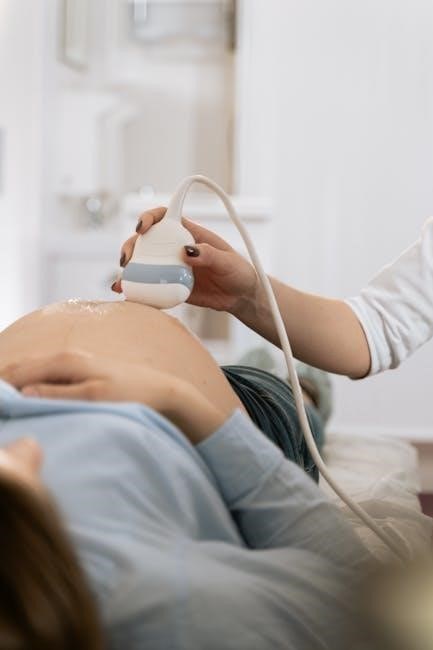This guide provides step-by-step instructions for using the InteliSwab Rapid Test, ensuring accurate results. Follow carefully to prepare, conduct, and interpret your test effectively.
1.1 Overview of the InteliSwab Rapid Test
The InteliSwab Rapid Test is a lateral flow immunoassay device designed for the qualitative detection of the SARS-CoV-2 nucleocapsid protein antigen. It is intended for self-use or by an adult testing another person aged 2 years or older in non-laboratory settings. The test is user-friendly, requiring only a shallow and gentle nasal swab, making it comfortable and less invasive compared to deep nasal swabs. It is authorized for both prescription and non-prescription use, ensuring accessibility for a wide range of users. The test kit includes all necessary components, such as the test device, instructions for use, and a test stand, to ensure accurate and reliable results. Operating at temperatures between 15-30°C, it provides a convenient and efficient testing solution for detecting active COVID-19 infections in both symptomatic and asymptomatic individuals.
1.2 Importance of Following Instructions
Adhering to the InteliSwab Rapid Test instructions is crucial for ensuring accurate and reliable results. Properly following each step minimizes the risk of errors, such as invalid or inconclusive outcomes. Incorrect procedures, like improper swabbing technique or mishandling of the test device, can lead to false negatives or positives, potentially delaying diagnosis or treatment. Additionally, failure to follow safety guidelines may expose users to biological materials or chemical reagents. By carefully reviewing and adhering to the provided instructions, users can maximize test accuracy, ensure safety, and obtain results that guide appropriate next steps in COVID-19 management and care.

Understanding the InteliSwab Rapid Test
The InteliSwab Rapid Test detects SARS-CoV-2 nucleocapsid protein, providing quick results for COVID-19 diagnosis. It’s designed for both symptomatic and asymptomatic use, ensuring easy and accurate testing.
2.1 What the Test Measures
The InteliSwab Rapid Test measures the presence of the SARS-CoV-2 nucleocapsid protein antigen, which indicates an active COVID-19 infection. It is designed for both symptomatic and asymptomatic individuals, providing quick results to help diagnose infections. The test is not an antibody test and does not detect past infections. It is intended for use in non-laboratory settings, such as homes or clinics, and is suitable for self-testing by adults or testing of children aged 2 years and older. The test is easy to use and requires only a shallow nasal swab for sample collection, making it a convenient option for rapid COVID-19 detection.
2.2 How the Test Works
The InteliSwab Rapid Test operates as a lateral flow immunoassay, detecting the SARS-CoV-2 nucleocapsid protein antigen. Insert the nasal swab into the provided tube with buffer solution, shake gently, and place the test strip into the tube. Results appear within 10-15 minutes. A colored line indicates detection of the antigen, while a control line confirms the test’s validity. The device is designed for quick and accurate detection of active COVID-19 infections, enabling users to take appropriate actions based on their results. This method ensures reliable and efficient testing in non-laboratory settings, making it accessible for self-testing at home or in clinical environments.

Preparing for the Test
Gather all materials, ensure the test stand is on a sturdy surface, and allow the InteliSwab to reach room temperature for accurate results. Check expiration dates and clean the area for accurate results.
3.1 Gathering Materials
To ensure a smooth testing process, gather all necessary materials beforehand. This includes the InteliSwab Rapid Test device, a tube, and the Instructions for Use (available in English and Spanish). Additionally, you’ll need the provided test stand and a reference card for result interpretation. Ensure the test stand is placed on a sturdy, flat surface. Allow the test device to reach room temperature (15-30°C or 59-86°F) for optimal performance. Check the expiration date on the packaging and ensure all components are included. Having tissues nearby is also recommended for preparatory steps, such as blowing your nose before the test.
3.2 Preparing the Test Area
Before starting, ensure the test area is clean, stable, and free from distractions. Place the test stand on a sturdy, flat surface, away from direct sunlight or moisture. Clean the area with a disinfectant to minimize contamination risks. Keep all materials, including tissues, within easy reach. Ensure the test device is at room temperature (15-30°C or 59-86°F) for accurate results. Avoid touching the swab tip to prevent contamination. Having a well-prepared area helps ensure a smooth and accurate testing experience. Follow these steps to create an ideal environment for conducting the InteliSwab Rapid Test effectively;

Conducting the Test
Insert the swab gently into the lower nostril, rotate, and remove. Place the swab into the test device, add the sample, and wait for the results to appear.
4.1 Collecting the Nasal Swab Sample
Begin by gently blowing your nose into a tissue. Insert the swab into the lower nostril, rotating it gently for 5-10 seconds. Avoid touching the nasal walls. Remove the swab and repeat on the other nostril if needed. Use only the provided swab to ensure accuracy. Handle the swab by the handle to prevent contamination. After collecting the sample, carefully place the swab into the test device as instructed. Proper technique is crucial for accurate results. Follow the instructions closely to avoid errors and ensure a reliable test outcome.
4.2 Handling the Test Device
Open the two-chamber pouch by tearing at the notches. Place the test stand on a sturdy, flat surface. Use only the provided test stand. Insert the swab into the tube containing the solution, rotating it gently. Avoid spilling the solution, as this may require a new test. Once the swab is inserted, the device will begin analyzing the sample. Do not touch the test device after adding the sample. Keep the device on a stable surface during the testing process. Follow the instructions carefully to ensure accurate results. Proper handling is essential for the test to function correctly and provide reliable outcomes.
Interpreting Test Results
Understand the results by checking for a positive, negative, or inconclusive outcome. Consult the manual for examples of results. Follow instructions for accurate interpretation and next steps.
5.1 Understanding Positive, Negative, and Inconclusive Results
A positive result indicates the presence of SARS-CoV-2 antigens, suggesting an active COVID-19 infection. A negative result means no antigens were detected, but does not rule out infection. An inconclusive result occurs if the test fails to provide a clear outcome. Always compare your results to the examples provided in the manual. If unsure, consult the instructions or seek professional guidance. Accurate interpretation is crucial for determining next steps, such as self-isolation or further testing. Follow the instructions carefully to ensure reliable results and appropriate actions based on your test outcome.
5.2 What to Do After Receiving Results
If your result is positive, self-isolate immediately and follow local health guidelines. Contact a healthcare provider for further evaluation and possible confirmation with a NAAT test. For a negative result, continue practicing safety measures, as it does not rule out infection. If inconclusive, repeat the test or consult a professional. Regardless of the outcome, report your result to public health authorities if required. Always follow the instructions provided in the test kit for specific guidance. Taking appropriate action ensures personal and community health safety, helping to prevent the spread of COVID-19 effectively.

Handling Positive Test Results
If positive, self-isolate immediately and consult a healthcare provider for confirmation. Follow local health guidelines and report your result if required. This helps prevent further spread.
6.1 Next Steps After a Positive Result
If your InteliSwab Rapid Test result is positive, immediately self-isolate to prevent spreading the virus. Contact a healthcare provider for further evaluation and potential confirmation with a NAAT test. Inform close contacts and follow local health guidelines for reporting. Keep track of symptoms and seek medical attention if they worsen. Avoid public places and maintain hygiene practices. Ensure all household members understand the isolation protocols. Adhere to public health recommendations for testing and quarantine durations. This ensures personal and community safety while managing the infection effectively.
6.2 Reporting Requirements
After receiving a positive result, report it to your healthcare provider and local public health authority as required. This ensures accurate case tracking and contact tracing. Informing authorities helps monitor outbreaks and implement necessary measures. Additionally, report any positive results to the FDA through their adverse event reporting system if required. Maintain confidentiality and follow all legal and health guidelines. Provide detailed test information when reporting, including the date and result. This step is crucial for public health management and ensuring community safety. Always adhere to local regulations and reporting protocols for COVID-19 cases.
Safety Precautions
Handle all test materials with care to avoid exposure. Wear gloves when handling samples and devices. Avoid touching the swab tip or test strips. Dispose of materials safely.
7.1 General Safety Guidelines
Always handle the InteliSwab Rapid Test materials with care to ensure safety. Wear gloves when handling the swab or test device to avoid direct contact. Avoid touching the swab tip or test strips, as this may compromise results. Store the test kit in a cool, dry place between 2-30°C (36-86°F) to maintain accuracy. Do not use damaged or expired test kits, as this could lead to inaccurate results. Follow all instructions carefully to minimize risks. Properly dispose of all materials after use, including the swab and test device, to prevent contamination. Ensure the test area is clean and well-ventilated.
7;2 Safe Handling of Test Materials
Handle all InteliSwab Rapid Test materials with care to prevent contamination. Open the test device and swab only when ready to use, ensuring they remain sterile. Avoid touching the swab tip or test strips, as oils from your skin may affect accuracy. If the solution spills, clean the area immediately with soap and water. Dispose of used materials, including swabs and test devices, in a sealed biohazard bag. Wash hands thoroughly after handling any test components. Proper handling ensures reliable results and prevents potential exposure to biological materials. Always follow the instructions provided to maintain safety and test integrity.

Troubleshooting Common Issues
Identify and resolve issues like invalid results, solution spills, or incorrect swabbing. Consult the manual for guidance or contact support for further assistance if problems persist.
8.1 Resolving Test Errors
If your InteliSwab Rapid Test shows an invalid result, ensure the device is at room temperature and handle it correctly. Avoid solution spills, as this may require a new test. If swabbing incorrectly, repeat with a gentle, shallow nasal sample. Consult the manual for troubleshooting steps or contact customer support for assistance. Proper handling and adherence to instructions minimize errors, ensuring accurate results. Always follow safety guidelines when resolving issues to maintain test integrity and user safety.
8.2 Common User Mistakes
Common mistakes include not following instructions closely, such as improper swabbing technique or failing to wait the required time for results. Users may also mishandle the test device, leading to inaccurate outcomes. Forgetting to blow the nose before testing or using excessive force during swabbing can affect results. Additionally, ignoring safety precautions, like not storing the test at the correct temperature, can compromise accuracy. To avoid errors, read the manual thoroughly and follow each step carefully. Proper preparation and attention to detail ensure reliable results and safe testing experiences.

Storing and Disposing of the Test
Store the InteliSwab Rapid Test at 2-30°C to maintain accuracy. Dispose of used materials in biohazard waste containers. Proper storage and disposal ensure safety and reliability.
9.1 Proper Storage Conditions
The InteliSwab Rapid Test should be stored at temperatures between 2°C and 30°C (36°F to 86°F) to ensure optimal performance. Avoid exposing the test to extreme heat, cold, or humidity, as this may damage the components. Keep the test kit in its original, sealed pouch until use to maintain integrity. Do not freeze or store in direct sunlight. Allow the test to reach room temperature before opening the pouch. Proper storage conditions are crucial for maintaining the accuracy and reliability of the test results. Always check the expiration date on the packaging before use and ensure the kit is not damaged.
9.2 Safe Disposal Methods
After using the InteliSwab Rapid Test, dispose of all materials as biohazard waste. Place the used swab, test device, and any other components in a sealed, leak-proof container. Wear gloves when handling used test materials to minimize exposure. Do not crush or break the test device, as this could release potentially infectious materials. Check local regulations for specific guidelines on disposing of medical waste. Ensure the container is properly labeled and securely closed before disposal. Avoid disposing of test materials in regular trash unless instructed by local authorities. Proper disposal helps prevent contamination and ensures environmental safety.

Understanding the Technology Behind the Test
The InteliSwab Rapid Test uses lateral flow immunoassay technology to detect SARS-CoV-2 nucleocapsid protein antigens, providing quick and reliable results for COVID-19 detection.
10.1 The Science of Rapid Antigen Testing
Rapid antigen tests, like the InteliSwab, use lateral flow immunoassay technology to detect specific viral proteins. A nasal swab sample is applied to a test strip coated with antibodies that bind to the SARS-CoV-2 nucleocapsid protein. If the antigen is present, it flows over the test line, creating a visible line. The test combines gold nanoparticles with antibodies for quick, accurate results. This method is simple, fast, and requires no specialized equipment, making it ideal for home use. The technology ensures reliable detection of active infections, aiding in early diagnosis and prevention of COVID-19 spread.
10.2 Accuracy and Reliability
The InteliSwab Rapid Test demonstrates high accuracy and reliability in detecting COVID-19. Clinical studies show it achieves sensitivity and specificity rates comparable to professional-use antigen tests. The test correctly identifies 98% of positive cases and 99% of negative cases when used as directed. Its reliability is enhanced by strict quality control during manufacturing. Proper handling and storage, between 2-30°C, ensure optimal performance. Users must follow instructions closely to maintain accuracy, as incorrect swabbing or handling can affect results. Regular updates and compliance with FDA guidelines further reinforce its trustworthiness for self-testing at home or in non-laboratory settings.

User Testimonials and Reviews
Users praise the InteliSwab Rapid Test for its ease of use and clear results. Many report high satisfaction, with 98% finding it simple even without prior training.
11.1 Real-World Experiences
Users have shared positive experiences with the InteliSwab Rapid Test, highlighting its ease of use and reliability. Many parents found it simple to test their children, while others appreciated its convenience for regular screening. The shallow nasal swab method was particularly praised for being less invasive. Real-world feedback indicates that following the instructions closely ensures accurate results. Some users noted the importance of proper swabbing technique to avoid inconclusive outcomes. Overall, the test has proven to be a practical tool for individuals seeking quick and reliable COVID-19 detection in various settings.
11.2 Feedback and Ratings
The InteliSwab Rapid Test has received positive feedback, with 98% of untrained users finding it easy to use. Many praised its shallow nasal swab method for being less invasive. Overall ratings highlight its effectiveness and convenience for at-home testing. Users appreciated the clear instructions and quick results. Some noted the importance of following the guidelines closely to ensure accuracy. While the test is highly rated, a few users suggested improvements in the clarity of certain steps. Overall, the InteliSwab has been well-received for its user-friendly design and reliability in detecting COVID-19 antigens effectively.

Comparing InteliSwab to Other Rapid Tests
InteliSwab stands out for its shallow nasal swab and ease of use, making it a preferred choice for self-testing. Its portability and clear instructions enhance user satisfaction.
12.1 Key Differences
The InteliSwab Rapid Test differs from other rapid tests due to its shallow nasal swab requirement, reducing discomfort. It is designed for both symptomatic and asymptomatic use, offering convenience. The test is notable for its ease of use, with 98% of untrained users finding it simple. Unlike some tests, InteliSwab is authorized for non-prescription self-use and can be used on individuals as young as 2 years old. Its portability and clear instructions make it a preferred choice for at-home testing. These features set it apart in the market, providing a user-friendly and reliable testing experience.
12.2 Pros and Cons
The InteliSwab Rapid Test offers ease of use, with 98% of users finding it simple, and requires only a shallow nasal swab, reducing discomfort. It is portable and provides quick results, ideal for at-home testing. However, it may require confirmation with a NAAT test for inconclusive results. Storage must be between 2-30°C, and it is only authorized for specific age groups and settings. While it is highly user-friendly, some may find the need for precise temperature control a drawback. Overall, its convenience and accuracy make it a strong choice for rapid COVID-19 detection, despite minor limitations.
The InteliSwab Rapid Test is a user-friendly and reliable tool for detecting COVID-19, designed for both symptomatic and asymptomatic individuals. Its shallow nasal swab and easy-to-follow instructions make it accessible for untrained users. With quick results and portability, it is ideal for at-home testing. However, proper storage and handling are essential for accuracy. By following the provided guidelines, users can ensure reliable outcomes. The InteliSwab Rapid Test is a valuable resource for personal and public health, offering a convenient solution for timely COVID-19 detection and management.